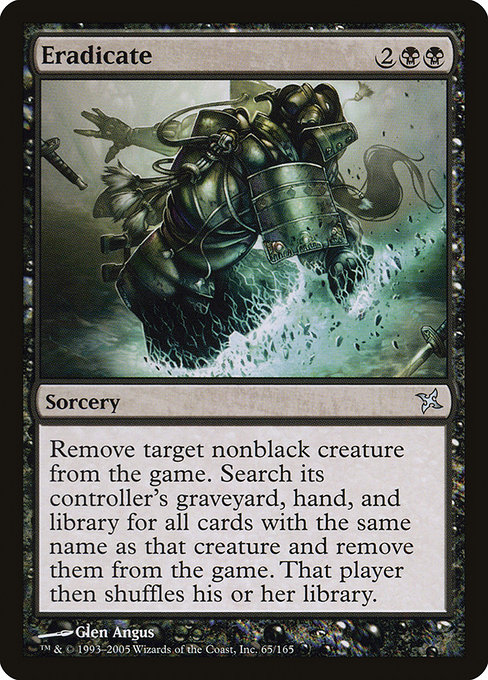
Image courtesy of Scryfall.com
Rarity vs Usability in MTG: Reading the Eradicate Dilemma
In the sprawling tapestry of Magic: The Gathering, rarity often hints at value, but true usability is earned on the battlefield. Eradicate, an uncommon sorcery from Betrayers of Kamigawa, embodies how a card can punch far above its weight class. It isn’t just about dropping a four-mana spell that removes a threat; it’s about turning a single removal into a strategic lock that reshapes an opponent’s entire deck-building approach. Let’s dive into why this black mana culmination—{2}{B}{B}—still feels bold in modern play 🧙🔥💎⚔️.
Eradicate at a glance
- Name: Eradicate
- Mana cost: {2}{B}{B}
- Type: Sorcery
- Colors / color identity: Black
- Set: Betrayers of Kamigawa (BOK), 2005
- Rarity: Uncommon
- Oracle text: Exile target nonblack creature. Search its controller's graveyard, hand, and library for all cards with the same name as that creature and exile them. Then that player shuffles.
- Legal formats: Modern, Legacy, Vintage, Commander, and more (format legality varies by era and ban lists).
Why rarity doesn’t determine impact
Eradicate’s uncommon status is a reminder that power isn’t confined to mythic or rare slots. In black’s wheelhouse, the card’s true value lies in its two-phase approach: first, remove a nonblack creature from the battlefield; second, purge every copy of that creature’s name from the opponent’s graveyard, hand, and library. That second clause can derail name-based engines, reanimation strategies, and tutor chains, effectively erasing a plan before it can fully assemble. Four mana for a targeted exile and a global name-removal sweep is a strategic bargain in formats where graveyard play and name-based interactions loom large 🧙🔥.
Play patterns and sequencing
Timing is everything with Eradicate. If your opponent has a single, pivotal nonblack creature threatening to snowball into a broader strategy, casting Eradicate on the right turn can do three things at once: kill the current threat, disrupt potential fetches and recursion tied to that name, and force the opponent to scramble through their deck to locate alternative threats. When the name in question shows up in the opponent’s hand or library, the exile from those zones further compounds the disruption, creating a moment where you’ve not just answered a creature, but also choked off a portion of their long-game plan 🎲.
In commander circles, Eradicate tends to find homes in midrange or control shells that lean on graveyard hate and name-based disruption. It’s not a one-card puzzle-piece for every matchup, but against decks leaning into tribal synergies or repeated fetches for a specific creature, it can be a game-warping play. The card’s flavor—erasing a name from the game—lands squarely in the mechanic-rich Kamigawa ethos, where cunning, strategy, and the expenditure of black mana unlocks counterplay that feels both clever and punishing 🎨.
Deckbuilding implications
When you slot Eradicate into a deck, you’re balancing between a clean answer and a potential multi-turn grind-stopper. In modern or legacy environments, you’ll want to couple it with other exile or hand-disruption elements to maximize the odds of hitting a name that appears across zones. In EDH/Commander, the card’s long-tail value shines as an inexpensive, flexible answer that can dismantle a single-name strategy while denying a toolbox of pseudo-answers from the opponent’s deck. The rarity is a non-factor in terms of strategic payoff; the real magic is the card’s ability to create a fleeting moment where one spell collapses an entire sub-game of “what if” into “this is what I have to deal with now.” 💎
From a collection perspective, Eradicate’s price tag is modest, reflecting its uncommon status and print history. Non-foil copies drift in the low single digits for most editions, while foils and some print variants can command a touch more. Its EDHREC footprint is a reminder that practical, situational tech can outsize many more prominent staples when the metagame leans toward graveyard play or name-based recursion. The rarity-to-usefulness delta here is a textbook case of how a card’s real-world value depends on how players leverage its exact text in the moment you draw it 🧠.
Art, flavor, and Kamigawa’s design philosophy
Glen Angus’s illustration for Eradicate captures a moment of decisive, almost surgical action—an exhale of black mana power that feels both ominous and precise. Betrayers of Kamigawa as a set leaned into intrigue and the tension between competing planes of existence, and Eradicate fits that mold by offering a spell that’s as much about the threat you can stifle as the name you’re erasing from the board. The 2003-2005 frame era brings a nostalgic glow for longtime players while delivering a clean, readable text box that makes your strategic choices clear on the stack. The narrative of erasing a creature’s name from the entire game aligns with Kamigawa’s themes of memory, consequence, and the costs of power ⚔️.
Value, data, and the practical takeaway
From a market perspective, Eradicate sits in a comfortable niche. It’s not a chase card, but it offers a reliable answer with a memorable effect. Scryfall data places it in a modest price tier for collectors who want playable legacy and commander options without overstretching their budget. The card’s real-world utility comes from its ability to alter the course of a game by removing both the current threat and its name from future draws—a dual-layer plan that rewards precise timing, deck construction, and a bit of meta-reading 🧙♀️.
As you curate your collection and build toward a balanced strategy, remember that rarity is only part of the equation. Usability—shaped by format, meta, and the synergy you weave around it—creates the true value. Eradicate is a shining example of how a relatively modest rarity can deliver outsized impact when deployed with patience, context, and a touch of black-mana bravado.